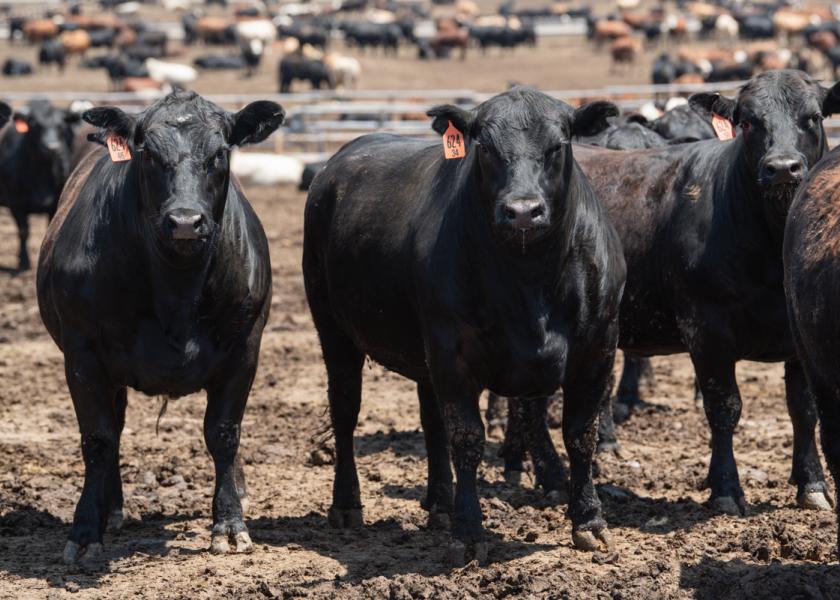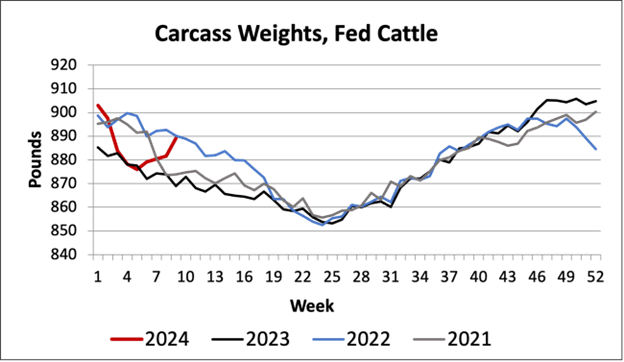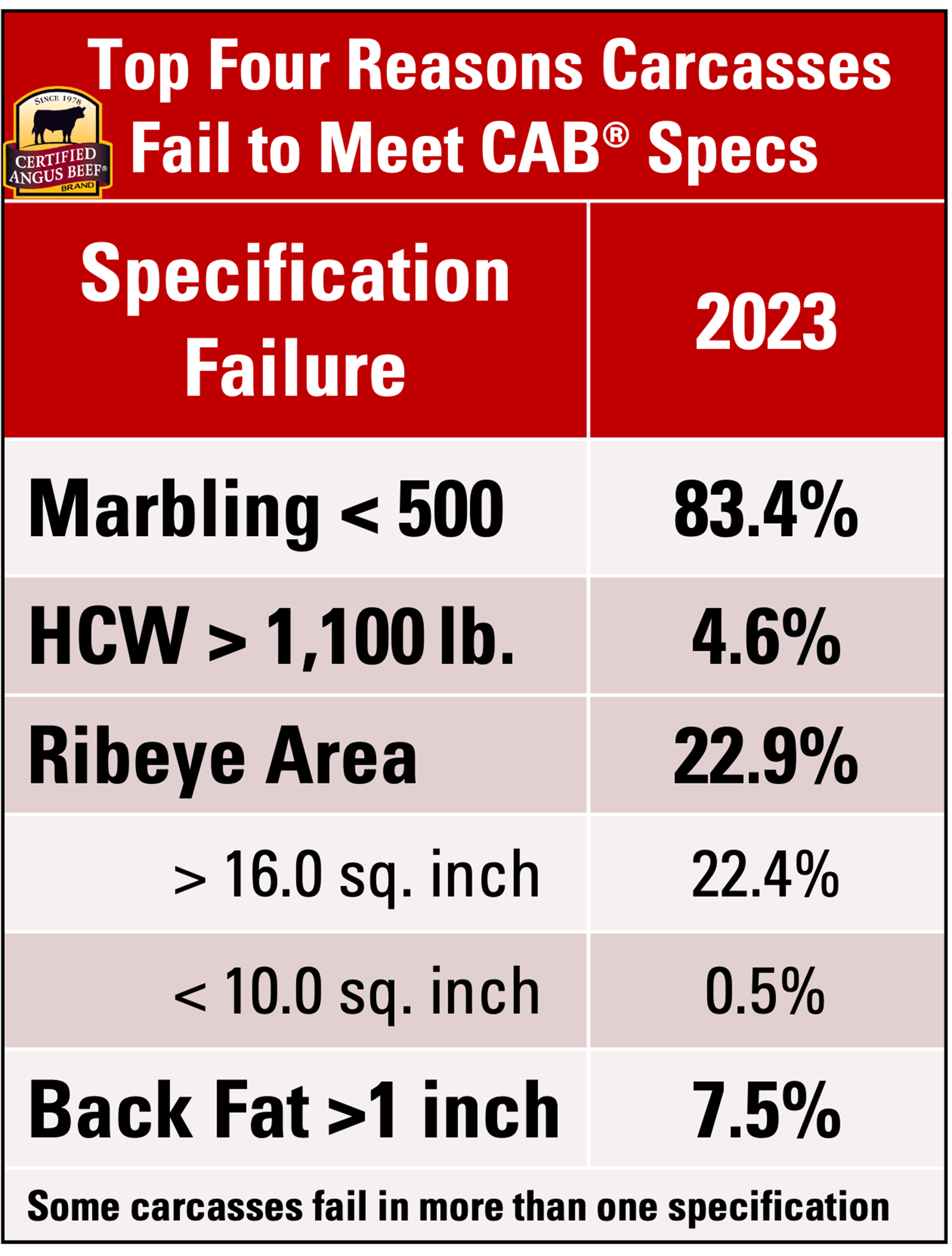CAB Insider: Where Do Carcasses Fall Short?

The cash fed cattle market has seen price advances slowly building since the second week in February. It’s been primarily a meticulous grind higher as the drastically reduced slaughter head counts kept a lid on market exuberance. Yet the last two weeks have featured a nearly $4/cwt. advance as bullish Live Cattle futures positioned price targets higher in the weekly cash market.

For the week ending on March 2, carcass weights took a big step upward. This was seen in the latest data with steers gaining 5 lb. and heifers up 12 lb. Not only are these big single-week gains, they are an elongation of a tremendous upswing from the winter-inflicted lows touched at the beginning of February.
The other factor in the carcass weights equation is the slowed pace of fed cattle slaughter. Packers have made a concerted effort to reduce production volume, aiming to hold cattle input prices lower while simultaneously pushing boxed beef prices higher.
Not without implications, the tactic has been only mildly successful in dampening the magnitude and speed of increasing fed cattle prices. Yet the rapid recovery in carcass weights suggests that finished cattle supplies are now not nearly as current as they were at the beginning of February.
The final piece of the carcass weight trend is the premium that Live Cattle futures have held over recent spot cash values. Declining costs of gain, coupled with premiums in futures, signaled cattle feeders to continue to feed their inventory. As winter weather turned milder, this captured margin.

Carcass quality (i.e. marbling scores) has not responded to rapidly increasing carcass weights in a manner intuition might suggest. The most recent data for the week of February 26 shows the national percent Choice grade declining eight-tenths of a percentage point over two weeks. As insignificant as that seems, it’s a setback in a season when we expect quality grade to trend toward a mid-March annual peak. The duration of the setback is very short term thus far. But it is the one trait that currently doesn’t correlate as observers may expect in a production setting where steer carcasses have seen a 10-pound boost in four weeks.
2023 Carcass Premiums Review
Dating back to 2008 we have collected detailed carcass measurements on several million Angus-type carcasses. Across 17 years the project has captured large data “snapshots” across multiple packers, increasing in frequency since 2019. The motivation is to capture large masses of data to continually update what we know about brand-eligible, Angus-influenced carcasses across the industry. While certainly imperfect, the 2.2 million carcasses evaluated in 2023 generate enough data points to offer credibility by way of volume.
CAB product sales volume is only as large as the supply chain will allow. This is pointedly apparent in the currently reduced cattle supply environment. Improved carcass merit has no downside regardless of supply cyclicity. Yet when beef production is restricted it magnifies the strides we should be making to get a larger proportion of Angus-type cattle across the finish line of all 10 carcass specifications for the brand.
The chart shows the reasons that Angus-type carcasses were excluded from the CAB brand in 2023. As has been the case in any of the 8 years studied, failure to achieve at least a 500 marbling score (the entry point to Premium Choice) explains the vast majority of carcasses that miss the target. That’s a discussion item for another day.

Next in line is ribeye area, where 22.9% of failures to meet the standards fell outside of the 10-16 square inch target. Just a fraction, 0.5%, were too small and the remainder were larger than 16 inches. This is easy enough to understand when considering the escalation in modern hot carcass weights, setting new records late in 2023.
The specification for maximum allowable hot carcass weight was changed in October 2022, shifting the limit up 50 pounds to the current 1,100 pound limit. The change shifted, with the 13.8% of carcasses that surpassed the 1,050 pound limit in 2020 to just 4.6% in 2023. This has proven to be a timely adjustment given the continued industry trend toward heavier carcass weights.
In the last two years, the correlation of carcass weight and ribeye size has driven the “cattle size” burden of disqualified carcasses over toward ribeye area and away from excess carcass weight. As the industry has fed cattle to heavier weights, the range in ribeye area sizes within a box of CAB ribeyes has actually narrowed. Since all carcasses are heavier, on average, proportionally more brand-eligible carcasses are crowding the 16 inch upper limit allowed in the brand and fewer are near the lower 10-inch lower limit.
It’s not often discussed in feedyard circles but carcasses with backfat thickness over 1 inch accounted for 7.5% of non-conformance for the brand in each of the past two years. Higher proportions of yield grade (YG) 4 and 5 carcasses, particularly YG 5’s, are associated with this level of excessive fat.
Feeding cattle to their optimum carcass composition and net return outcomes is an evolving process. The largest opportunity to push more cattle from a contemporary management group into CAB-brand acceptance remains squarely in improved marbling. Managing for “outs” in areas of excess size and fat content not only increases CAB carcass certification but hits the bottom-line reducing grid discounts.







